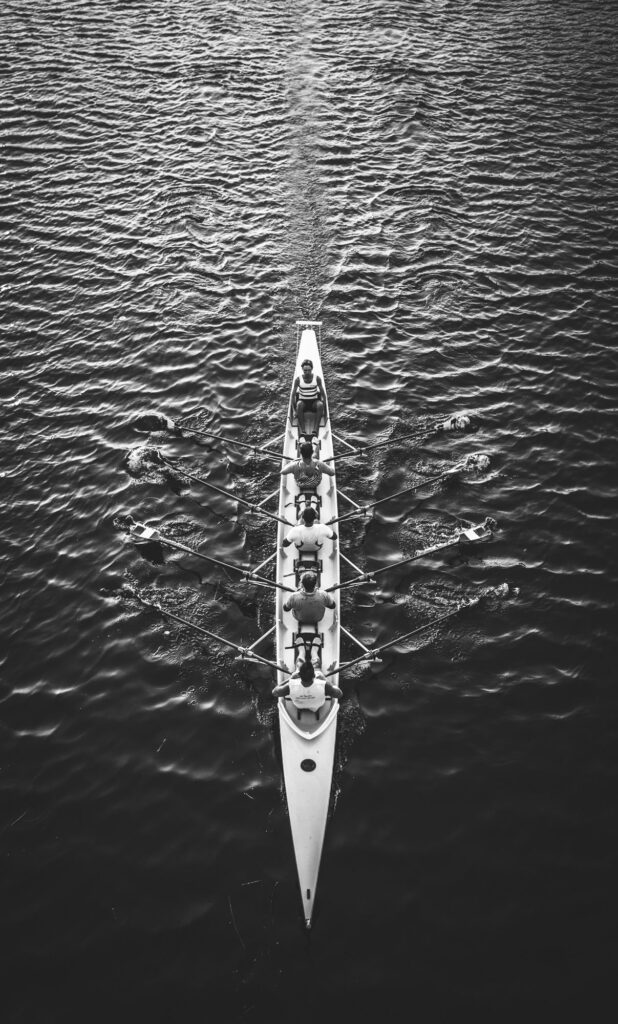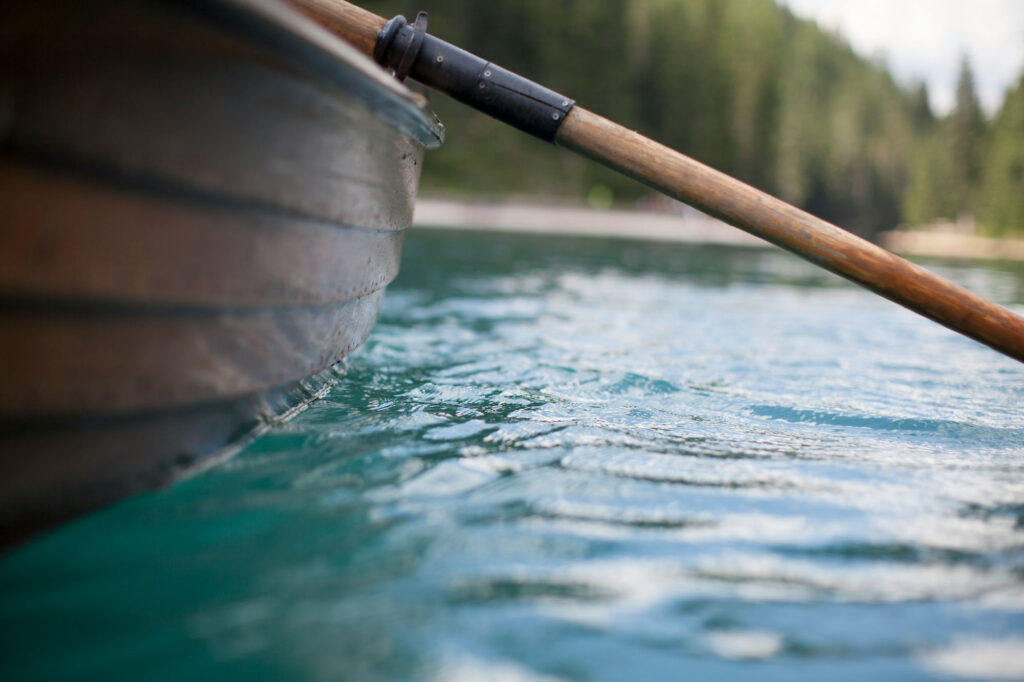Inspired by The Boys in the Boat story? Ready to get your oars in a row? Katie Malik of Gig Harbor Boat Works offers her take on the beloved pastime—and advice for breaking into the pursuit—so that you, too, can expertly make your way through the sea.
By Katie Malik

The late 2023 release of The Boys in the Boat film, based on Daniel James Brown’s 2013 book recanting the true tale of the 1936 University of Washington crew team, sure has renewed and reinvigorated interest in the age-old sport of rowing. For people duly inspired and now interested in getting into rowing, there are several ways to go about it—and you don’t need to be a super-fit collegiate athlete to enjoy the hobby. All it takes is two arms, two legs, and a good rowboat to get exercise while exploring the Northwest’s waterways.
The real-life story of The Boys in the Boat is a point of pride in the local rowing and small-craft community. When the UW’s scrappy rowing crew won the 1936 Olympic gold medal (in Nazi Germany, no less), they instantly became local heroes. In the 1930s, crew racing was an elite sport dominated by Ivy League schools back East, so the Huskies’ success was akin to a country cousin thumbing its nose at the big city boys. Seattle was a young, working-class city at the time and the community swelled with pride at the success these local athletes achieved.
Rowboats were common throughout the Puget Sound back then, but they were mostly workboats used by working-class folk who made their living from the water—fishing, hauling cargo, or ferrying passengers. These rowboats looked nothing like the narrow rowing shells of elite racers. They were wider, more stable, and designed for practicality—not speed. Outboard motors of that era were scarce and prohibitively expensive, so rowing was essential. Today, people who’ve never rowed a good rowboat might have a misconception that rowing is hard work, and it’s exhausting to row very far. However, these workboats were designed to be rowed day in and day out, so they were (and still are) remarkably efficient and could be rowed for hours without fatigue. To the working folk, efficiency and practicality were critical to making a living.
The “boys” on that famous UW crew team mostly came from working-class backgrounds, so they would have grown up with rowing workboats—not the slick, fast racing shells used by the elites. That’s a big part of what made the underdogs’ Olympic success so special.
For a vast majority of today’s recreational rowers, the traditional “working” rowboat is a more user-friendly and versatile design—the same reasons it was so popular 100 years ago. Let’s look at some of the key differences that you need to know if you’re thinking of getting a rowboat of your own.
Racing Shells vs. Working Rowboats
A good crew shell looks like a dart: long, skinny, and designed to rapidly slice through water. They don’t have to carry cargo or catch fish—their sole purpose is to be light and fast. Since crew regattas happen on flat waters and sacrifice stability for speed, crew shells aren’t built to handle even moderate seas.
While boatbuilding technologies have changed, the laws of physics have not. Compare the 1936 Husky men’s boat to say, the current Husky women’s boat, and you can see how elite shells have the same essential shape.
If the team spirit and athleticism of formal crewing are appealing to you, there are several reputable crew houses around Seattle for those interested in competitive racing. (Seattle-based Lake Washington Rowing Club, Lake Union Crew, Green Lake Crew, and, naturally, the Pocock Rowing Center, are all more than worth their salt.) But for people that simply want to row solo for pleasure and exercise, and don’t feel the need to race, crew shells are impractical. Buying a racing shell to row around Puget Sound is like driving a race car to work; it doesn’t make a lot of sense. The lack of stability and narrow sitting area (as narrow as 10 inches on some single crew boats) takes some finesse, and the long length (typically 25 feet or more) makes them difficult to launch and transport unless you house them at a rowing club. True, shells are much faster, but for most of us, the sustainable 4-5 knot hull speed of a good working rowboat is fast enough.
Outriggers or No Outriggers?
Additionally, rowing shells are so narrow that they require outriggers to create a wide enough support to hold their oars, but a well-designed rowboat doesn’t need them. Outriggers make docking more complicated and are also really good at snagging fishing lines.
Notice outriggers aren’t used in this shot of a crowded rowboat seen on this page where President Harry Truman is standing up and holding a fish, caught during his trip to Puget Sound in 1945. And the stability this boat displays as he stands with his catch is another big plus of the traditional rowboat design. Notice outriggers also are missing in the historic snap of the Point Defiance fleet of rental rowboats from that same era, where people needed forgiving, easy-to-use boats for their fishing expeditions. The stability these boats offered is another big plus of the traditional rowboat design
Wooden rowboats still exist, but today nearly all commercially available crew boats, row boats, and tenders are built of modern composites such as fiberglass that provide better strength to weight ratios, longevity, and ease of maintenance.
Modernizing the Classic Rowboat
Local small-craft boatbuilder Gig Harbor Boat Works—the company my dad, Dave Robertson, founded in the 1970s out of our family garage and where I currently serve as general manager—takes a “best of both worlds” approach, continuing the legacy of Puget Sound’s classic workboat heritage. Our boats combine modern materials and construction techniques with timeless designs that offer versatility to the modern boater who wants to row, fish, sail, and explore small waterways off the beaten path.
For example, the Gig Harbor 14’ Whitehall in lightweight fiberglass has the same classic lines as its wooden namesake, yet offers the sleek performance of a sculling rowboat. Its most noteworthy innovation for modern rowers is a unique integrated sliding seat. It combines the versatile bench seat of the working rowboat, leaving the floor open for gear or cargo, with a rolling mechanism that lets you use the full-body ergonomics of a scull. The seat can also be easily locked in place for fixed position single or tandem rowing. It pairs well with 8-foot spoon oars, with no outriggers needed.
Gig Harbor’s longer 16- and 17-foot skiffs, the Melonseed and Salish Voyager, also have optional tandem sliding seats so you can row with a partner, and work with up to 9.5’ oars with no outriggers needed. They also come in sailing versions so you can get a rowable, sailable, and outboard-motor compatible vessel—three boats in one.
The versatility of a classic rowboat can help unlock everyday adventures in Puget Sound and beyond. As people look for eco-friendly ways to get out on the water, row for exercise, explore our native waters, or even channel and connect to our forebears, perhaps the answer lies in the adage that everything old is new again.
ANSWERING THE CALL
If you’re thinking of getting into rowing, it’s important to think about your objectives. Answer the following questions and find the right choice for you:
- Do you want to race? If you are the competitive, athletic type, then you probably won’t mind the limitations of a scull and can focus on training in a similar setup as you have in your competitive environment.
- Do you want functional fitness? If you want the great functional full-body fitness that rowing provides, but want a more stable and forgiving rowboat, a solo sliding-seat rowboat like a 14-foot Whitehall is ideal. If you have a partner who wants to join you often, consider a 16.5-foot Melonseed, which has an optional tandem sliding seat that can accommodate two people rowing.
- Do you want to row for pleasure, perhaps while you fish or take family with you? Make sure your choice prioritizes capacity and versatility. If you want a versatile boat for the family, Gig Harbor’s 12’-foot Point Defiance, 16-foot Melonseed, and 17-foot Salish Voyager are popular options.
- Do you want to sail, too? It doesn’t take much to turn a great rowboat into a great sailboat, so all Gig Harbor Boat Works rowboats are available in sailing versions. The 17-foot Skiffs are popular for those who want sliding rowing seats and fun sailing performance. Or if you’re just looking to row, sail solo, and keep things simple, the small sailing/rowing dinghies are a lot of fun for one.
>> For information on Gig Harbor Boat Works’ vessels, go to: ghboats.com; and be sure to also check out their Blog for more informative writings from Malik and others in the rowing community.
